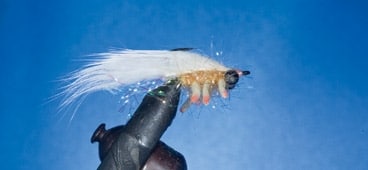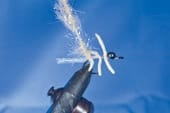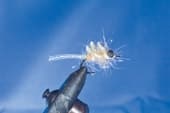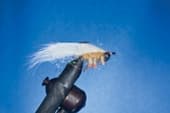
11ftb
The fly-fishing world has always had its share of amazing tiers – innovators who came up with new and different ways to use materials, old and new alike.
I often find it difficult to be creative when it comes to designing a new pattern. Some might wonder, “Why bother? There are hundreds of flies out there that have proven themselves time and time again on all of our favorite species.”
I like the challenge of throwing Mother Nature for a loop and fooling with eons of fishy evolution; it’s an extremely satisfactory feeling when you finally succeed.
When faced with a creative block, I rely on the tips and tricks I’ve collected and borrowed from the many gifted tiers I’ve encountered – and read about in these pages – over the years. Dave Skok is certainly one of them. I love his idea of using rabbit strip to emulate the carapace of a crab in his Blind Crab – eliminating the time-consuming task of tying-in, teasing and trimming sections of yarn.
There are some great crab imitations made from epoxy as well but, if you’re anything like me, you probably avoid using the sticky stuff whenever possible. I’m just not one of the lucky ones born with the skills to turn a sticky, messy blob of curing material into a glistening, lifelike crustacean imitation. Plus, I’m not a big fan of using anything that might put a strong chemical scent in the water when it’s not necessary.
So, that’s how I developed the Buggy Bunny.
One of my favorite aspects of this pattern is its legs. A little over four years ago, Ashley Cornelius of Don’s Bait and Tackle showed me a way to make the most lifelike crab legs using micro-chenille and a cigarette lighter (see Step 3 of the tying instructions).
Fish are opportunistic feeders, and I don’t believe they spend a whole lot of time “studying” their meal. Instead, they key-in on the most distinguishing characteristics of their favorite menu items – the eyes on a baitfish, the jiggy movement of a shrimp or jointed legs on a crab. These distinguishing characteristics trigger fish to eat.
Finally, to add a little flare and finish off the fly, I knew it was going to need some kind of body. I tried several types of chenille and settled on cactus chenille. Weaving the hackle in and around the legs along the shank of the hook, it actually gave the fly a very buggy look. By topping it off with a bunny-strip carapace, a fly – the Buggy Bunny – was born.
No matter what your final new creation ends up being, it’s more than likely derived from another pattern or incorporates a few borrowed features. In this case, the end result yielded a fly that looks appetizing, casts well, doesn’t foul and has already produced over and over in its short existence. Try the Buggy Bunny anywhere the fish eat crabs; some of my favorite applications include black and red drum as well as permit and bonefish. Play with its size, dimensions and colors, and you’ll find a lot of fish asking “What’s up, Doc?”
**Tying Instructions
** Step 1: At the bend of the hook, tie in 1/2 inch of mylar tubing (with core removed). On top of the tie-in point, attach a 5-inch strand of cactus chenille.

Step 2: Wrap the thread to the eye of the hook. Tie-in dumbbell eyes about 1/8 inch away from the eye of the hook.

Step 3: Cut three strands of micro-chenille, each 3/4 inch in length. Holding each strand with forceps, run the chenille quickly through the flame of a lighter until the material shrinks to the core. Space burned leg sections out along the shank and tie-in, leaving the thread at the eye of the hook.

Step 4: Wrap cactus chenille up the shank of the hook, weaving through the chenille legs, then tie-off at the eye of the hook.

Step 5: Cut a 1-inch section of bunny strip (looking at the skin side). Using a sharp pair of scissors, puncture a hole in the bunny strip. Gently work the hook point through the hole and stretch the other end towards the eye of the hook. If necessary, trim the strip. Tie-off and whip-finish.










